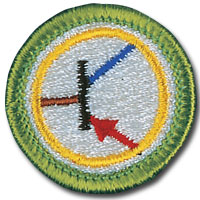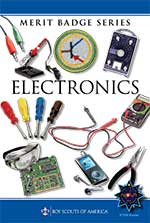THE SCOUT OUTDOOR ESSENTIALS
They’re called “essentials” for a reason. Every packing list starts with these 10 items.
1. A pocketknife or multitool can be handy in a wide variety of situations. It’s useful for tasks as large as building an emergency shelter or lighting a campfire with poor fuel, or as small as repairing a damaged backpack. Keep you knife sharp and clean, and don’t forget to first earn your Whittling Chip (for older Cub Scouts) or Totin’ Chip (for Boy Scouts).
2. A first-aid kit can be a lifesaver. Literally. A few items will allow you to treat scratches, blisters and other minor injuries. They should also allow you to provide initial care while waiting for help for more serious injuries.
3. Bring extra clothing to match the weather. Multiple layers are better than a single massive jacket, because layered clothing is adaptable to a wide range of temperatures.
4. Rain gear is very important. Rain can come in a hurry, and getting your clothes drenched is more than just uncomfortable, it can lead to hypothermia, a potentially fatal condition.
5. A flashlight, headlamp or a rugged penlight is important for finding your way in the dark. Bring extra batteries, too.
6. Trail food is good for maintaining your energy. Bring more than you think you’ll need in case you get stuck (or lost) in the woods.
7. Water can prevent dehydration, heat exhaustion and heatstroke. Use a lightweight, unbreakable container with a secure lid.
8. Matches and/or a fire starter may be used to light fires for heat, or for signaling for help. Store matches or lighters in resealable plastic bags.
9. Sun protection might include sunblock, sunglasses, lip balm and a wide-brimmed hat.
10. A map and compass are probably the most important tools you can carry in case you get lost.
KEEPING CLEAN
Here are some hygiene items you may want to pack, depending on the outing:- Toothbrush
- Toothpaste
- Dental floss
- Soap
- Comb
- Waterless hand cleaner
- Small towel
- Washcloth
- Toilet paper
- Trowel for digging cathole latrines
COOKING AND EATING
Here are some cooking and eating items you may want to pack, depending on the outing:- Large plastic cereal bowl or kitchen storage bowl
- Spoon
- Cup or insulated mug
- Water treatment system
- Backpacking stove with fuel
- Large pot and lid (2.5- or 3-quart size)
- Small pot and lid (1.5- or 2-quart size)
- Lightweight frying pan (10 to 12 inches in diameter)
- For melting snow, add 1 large pot and lid (6 to 10 quarts)
- Hot-pot tongs
EXTRAS
Here are some extras you may want to pack, depending on the outing:- Watch
- Camera
- Notebook
- Pen or pencil
- Sunglasses
- Small musical instrument
- Swimsuit
- Gloves
- Whistle
- Nylon cord
- Insect repellent
- Repair kit
- Hiking stick or trekking poles
- Binoculars
- Fishing gear
- Animal identification books, plant keys, geological studies, star charts or other guides


